The Con Man
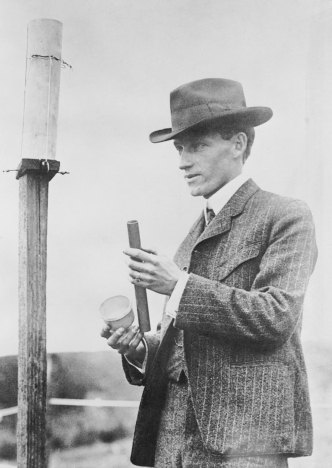 Charles Hatfield, the rainmaker, checking some equipment. (Copyright Bettmann/Corbis/AP Images)
Charles Hatfield, the rainmaker, checking some equipment. (Copyright Bettmann/Corbis/AP Images)When San Diego was facing a historic drought in 1915, the city council turned to an unlikely character to solve their crisis: Charles Hatfield, a 40-year-old sewing machine salesman and “rainmaker.” For $10,000, the self-styled “moisture accelerator,” vowed to produce enough rain to fill the Morena Dam reservoir within a year. With the city council’s agreement, Hatfield and his brother constructed a 20-foot tower east of the city, topped with a secret mixture of 23 chemicals he claimed would attract rain.
From the Los Angeles Times: “What followed in January and early February of 1916 was a downpour — 30 inches of rain by some estimates. Mission Valley flooded. The San Diego River jumped its banks. Farms, homes, bridges and businesses were swept away. Estimates of the deaths range from a dozen to 50.”
Hatfield claimed he fulfilled the terms of his contract, but the city council refused to pay his $10,000 fee unless he accepted liability for $3.5 million in damages. Hatfield first tried to settle for $4,000, then sued the city council. The legal battle continued for years until the San Diego County Superior Court ruled that the rain was an act of God, releasing Hatfield from liability but forfeiting his fee.
 Aerial Photo of Otay River Flood Damage in 1916, photo courtesy of the San Diego History Center.
Aerial Photo of Otay River Flood Damage in 1916, photo courtesy of the San Diego History Center.The real rainmaker was an area of high pressure and three Pacific storms that lingered over the region for weeks. And the secret behind Hatfield’s scheme had nothing to do with a mysterious mix of chemicals, but rather his arrival in towns across America, promising rain right at the end of the dry season.
The Flood
The Great Flood of 1916 damaged two dams. A third, the Lower Otay Dam on the Otay River, failed on January 27, 1916, sending a 40-foot wall of water racing downstream. More than 100 years later, the devastating effects of the dam failure and the resulting flood are still impacting the area. Thousands of tons of silt, sand, and debris washed downstream, some of which made it all the way into San Diego Bay. From the 1960s to the mid-1980s, mining operations on the Otay River floodplain extracted the sand and gravel left behind, but at the time, there was no requirement for ecological restoration at the site.
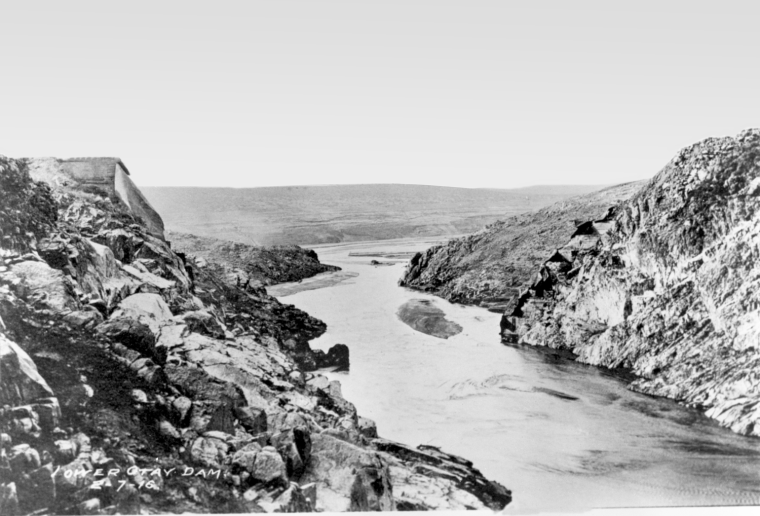 Lower Otay Dam 1916, photo courtesy of the San Diego History Center.
Lower Otay Dam 1916, photo courtesy of the San Diego History Center.Shortly after the Lower Otay Dam failure, in 1918, the City of San Diego reconstructed the dam, renaming it the Savage Dam. Today, the city uses the Lower Otay Reservoir primarily for drinking water, and only occasionally releases water downstream, typically when the reservoir nears its 47,000 acre-feet capacity (about once every 10 years). With the lower Otay Valley disconnected from the rest of the watershed at the dam, the flow is too low for the river to self-repair. The river has no defined channel, even flowing underground in some areas, and cannot naturally move sediment through the floodplain.
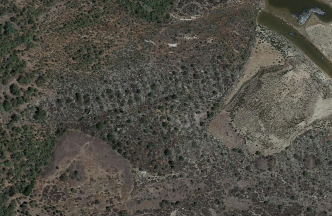 Satellite view of mine tailing strips.
Satellite view of mine tailing strips.The soil of the river valley, disturbed by the historic flooding and years of mining operations, has become prime real estate for invasive plant species to take root. Today, non-native tamarisk dominate the floodplain landscape along with pepper trees, eucalyptus, and palms. With so many factors working against it, it’s no surprise that the natural processes of the Otay River have been significantly altered. To return the area to a naturally functioning ecosystem, the river is in need of a serious restoration effort.
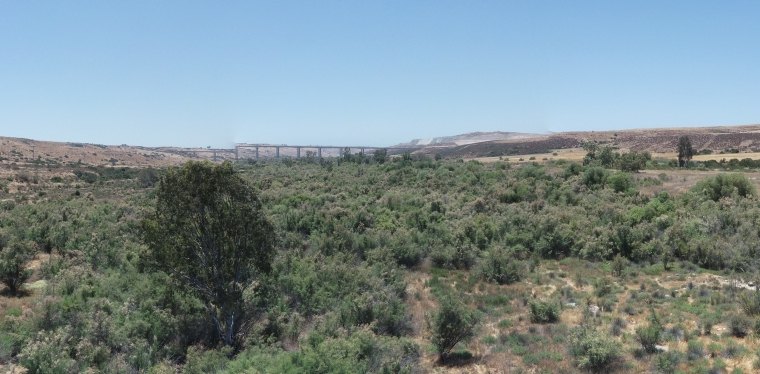 Invasive tamarisk, eucalyptus, and pepper trees dominate the landscape.
Invasive tamarisk, eucalyptus, and pepper trees dominate the landscape.The Restoration
Driven by the need to offset planned housing developments, the Otay River Restoration Project (ORRP) kicked off in 2016. The population around San Diego has boomed, and development has been quick to keep pace. HomeFed Corporation, a mixed-use real estate development company, is working with the neighboring landowner City of Chula Vista to restore and use this area as a mitigation bank.
In 2021, HomeFed selected SWCA as the program manager to oversee all aspects of the mitigation lifecycle. Currently, SWCA oversees the design and engineering of the project’s two main components:
- 2016 Restoration Project: Maintain and monitor more than 38 acres of river, floodplain, and upland restoration in the most upstream portion of the river
- Mitigation Bank Expansion Project: Restore more than 250 acres of river, floodplain, and upland habitat in an area directly connected to the initial restoration

The floodplain restoration in the second area includes creating a braided channel network for better water flow, removing invasive species, and revegetating native riparian and wetland species. In the upland areas, the team is establishing depressional and vernal pools and restoring coastal sage scrub habitat. Over the next year, SWCA will initiate construction oversight, monitoring, reporting, and overall orchestration of the mitigation bank phase of the project, including adaptive management as needed.
What is mitigation banking?
Mitigation banking is a legal mechanism whereby ecological improvements are made to areas of need in order to offset ecosystem losses in other places. Successful restoration work creates various types of credits within the mitigation bank, including credits for aquatic resources and select sensitive species. Similar to an account at a financial bank, HomeFed can save these mitigation bank credits for later projects, spend them as needed for current developments, or sell them to others who need to offset ecosystem losses for their own projects.
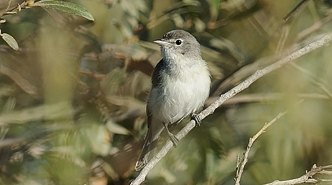 Least bell’s vireo, photo courtesy USFWS
Least bell’s vireo, photo courtesy USFWSFor example, some of HomeFed’s restoration work on the ORRP will help create and restore habitat for the least Bell’s vireo (Vireo bellii pusillus), a federally endangered songbird that relies heavily on healthy riparian habitat. If another project elsewhere in the mitigation bank’s identified service area negatively impacts the least Bell’s vireo habitat, that project can purchase credit from HomeFed to offset the habitat loss. This type of exchange is permitted through the various wildlife and aquatic resources agencies, with a minimum of one acre of habitat or territory impacted in exchange for one acre of habitat restored (although in most cases, regulatory agencies require a greater than a 1:1 ratio to offset the impact). By ensuring no net loss across the service area, the vireo is not losing out on valuable habitat.
New project proposals that involve an existing mitigation bank tend to have a leg up with regulators. It’s much more efficient to buy credits from a mitigation bank than to spend the time and resources to create a restoration project from scratch. Similarly, the resource agencies benefit when a bank is available for use because it ensures a level of standard for the restored resources, streamlines the regulatory process, and can create efficiencies in their workflow. SWCA is preparing the final mitigation banking documents and permitting, as well as facilitating agency coordination, marketing credit reservations, and informing the public.
The Winning Team
Restoring natural habitat is a boon for the plant and animal species that live there, like the least Bell’s vireo, San Diego fairy shrimp (Branchinecta sandiegonensis), California Ridgway’s rail (Rallus obsoletus obsoletus), Quino checkerspot butterfly (Euphydryas editha quino), and a number of other sensitive species in and around the Otay Valley. But the benefits of restoration projects extend far beyond the local ecology.
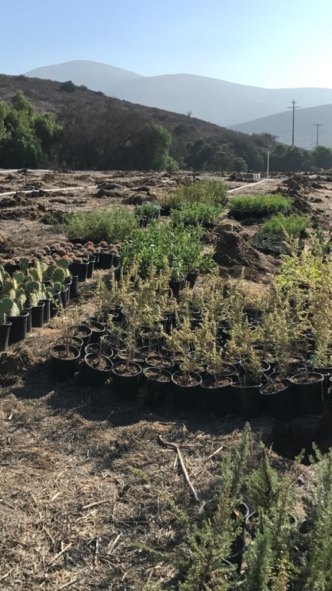 Native species are planted to encourage a return to the floodplain’s natural ecosystem.
Native species are planted to encourage a return to the floodplain’s natural ecosystem.The City of Chula Vista will be one of the long-term preservation managers of the area, along with San Diego County and the City of San Diego. Because it is being completed on publicly owned land, part of the project includes developing a 5-mile network of multi-use trails within the City of Chula Vista Greenbelt Trail Corridor, a connection to the Otay Valley Regional Park System, and educational signage. After implementation, hikers, mountain bikers, and equestrians will have easier access to this rural trail network, not something usually found in such close proximity to a coastal urban area.
“With that public access, we hope there will be some educational opportunities too,” said Lindsay Teunis, a San Diego native and SWCA principal restoration ecologist who has worked throughout many phases of the ORRP. “That could look like field trips for K-12 students, college students, even some graduate or Ph.D. candidates who want to do research in the area.”
The restoration area also overlaps with the traditional lands of the Kumeyaay Nation, another key stakeholder in the ORRP. “We’ve been engaging with the Kumeyaay people, in particular at Kumeyaay Community College, to get students involved in preserve management, adaptive management, and use of land. As the original stewards of the land, we want to make sure that they are as involved as possible. The project is at the beginning stages of collaboration with the Kumeyaay, but we are excited and eager for the next steps.”
The ORRP goes above and beyond basic regulatory compliance. “From the beginning, HomeFed has always encouraged a high-quality mitigation product, and it’s something I know they are proud of as well,” said Teunis. “Mitigation banking is one of the best uses of private dollars on public land in that, when done properly, the benefit to the public land is a lift, not a burden—and is often done at a cost that is not easily covered by grants or public funding.”
“I love big, complex restoration projects like this,” Teunis added. “Not only because we get to do some of our best work with a strong team across SWCA, but because mitigation projects are really a win-win-win. We leave the local ecosystem better than we found it, the clients are happy because their projects can move forward and they open additional revenue streams, and the community stakeholders benefit from better water quality, a more robust and functional ecosystem, and new opportunities to explore and play in this great part of nature.”
See more details on the Otay River Restoration Project website. For more information, contact Lindsay [dot] Teunis [at] swca [dot] com (subject: Otay%20River%20Restoration%20Project) (Lindsay Teunis).
